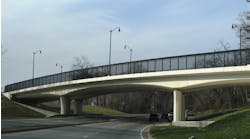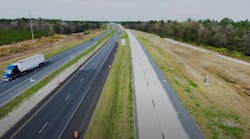Reconstruction of the Vienna-Salzburg A1 motorway began in 1991, and the last job near Vorchdorf in Upper Austria will be finished in September 2012.
The original motorway, which runs from Vienna through the provinces of Lower and Upper Austria to Salzburg, is one of the main transit routes between Eastern Europe and the west. It is 300 km long and was built with a concrete pavement between 1955 and 1978, with small sections built much earlier (immediately before World War II by the Germans and after the war by the U.S.).
In 1990 the oldest sections were 40 to 50 years old and needed reconstruction, and it was evident that other sections would have to be reconstructed as well. Capacity also was an issue. With the fall of the Iron Curtain, traffic increased tremendously, not only adding load to the existing pavement, but also requiring a six-lane carriageway instead of four lanes.
A thick overlay was not an option because there were too many bridges unable to bear the additional load. The existing pavement needed to be replaced by a new one, but dumping facilities were scarce, the use of virgin aggregates for 300 km of motorway was considered a waste of resources and the necessary transports were environmentally disadvantageous.
The second problem was traffic noise, which had become a public issue, because traffic had increased so much, mainly by heavy vehicles crossing the country. Unfortunately, the old concrete pavements were noisier than most asphalt pavements due to studded tires exposing the coarse aggregate, causing the tires to emit a rumbling noise. A ban on concrete pavements for motorways was imminent.
It was known that longitudinal textures provided very satisfactory long-term performance in the U.S. and Spain. Different longitudinal textures (burlap, comb, different brooms) were used on two motorway jobs in Austria in the late 1980s. All were low noise at the beginning, but the texture was worn away by traffic within a year or two, and the coarse aggregate appeared and tire-road noise increased. Textured surface mortar is not durable under Austria’s conditions (up to 25% of heavy vehicles, use of deicing chemicals and chippings in winter, and studded tires). Ultimately, the structure of the concrete determines the noise level.
An old way of doing it
The Research Institute of the Austrian Cement Makers suggested to solve the material problem by recycling the old concrete pavement of the A1 into the new bottom lift and the noise problem by means of a fine-grained, exposed-aggregate concrete for the top lift, also ensuring a strong grip. Two-lift construction has always been customary in Austria. Both gravel and crushed stone are available, but stone resistant against wear and polish is more expensive.
Samples from different concrete pavements up to 50 years old had already been tested in the early 1980s. The concrete was found to be sound (no freeze-thaw damage, no akali-silica reactivity) with compressive strengths between 10,000 and 15,000 psi—as much as many natural stones. The samples were crushed in the laboratory. The coarse aggregate thus obtained was used for making concrete specimens and proved to be at least as good as virgin gravel. It bonded more readily with the new cement stone, giving (at the same w/c) higher flexural strengths than quartz gravel.
Thin asphalt overlays had been placed to fill the ruts produced by the studded tires (much in use then and still allowed today). Therefore, the recycled concrete aggregate (RCA) would contain some asphalt. The effects of this on the properties of the new concrete were not yet known.
The Ministry of Taffic, Innovation and Technology (then headed by Wolfgang Schüssel, the later chancellor of Austria) sponsored the necessary laboratory work on condition that the research institute also would help to implement the results on motorway trials to be built within a year.
Sizing up samples
The day before Christmas Eve 1989, the Salzburg DOT deposited a truckload of 50-year-old concrete pavement on the sidewalk of the Cement Research Institute in Vienna. A sample of the asphalt overlay also was provided.
The concrete and the asphalt were crushed separately, wet sieved into fractions and used for making concrete specimens.
First, concrete specimens were made without any asphalt, one series with recycled concrete aggregate (RCA, water saturated) for the fractions 4?8, 8?16, and 16?32 mm and virgin sand 0?4 mm; another series with RCA also in the fraction 0?4 mm. The first one met the requirements for frost resistance, while the latter did not. This was attibuted to the weak material that had collected in the fine fraction and the higher amounts of sulfate and alkalis. Its high amounts of cement stone also would have led to more shrinkage. So it was decided to use only the 4?32-mm RCA and 0?4-mm virgin aggregate for the new concrete.
Then concrete samples were made with different amounts of asphalt added to the RCA fractions. Astonishingly, asphalt contents of up to 20% did not essentially impair the compressive strength of the concrete, and the flexural strength was still considerably higher than when (at the same w/c) quarzitic gravel was used and no asphalt added. On the jobs, the asphalt contents in the RCA never exceeded 10%. To meet strength requirements, 365 kg/cu meter of cement was necessary. Shrinkage was in the range of the values for concrete with different virgin aggregates used in Austria.
For the exposed-aggregate concrete, the maximum aggregate size was reduced from 22 mm to 8 mm, and 0?1 mm of sand and 1?4-mm gap grading allowed about 70% of 4?8-mm chippings to be used. In order to ensure good bond of the small aggregate (and prevent the studs from plucking it out), the w/c ratio was reduced to 0.38—as low as was feasible on the job with the plasticizers available in 1990. Accordingly, the requirement for flexural strength was increased from 800 to 1,000 psi at 28 days and 450 kg/cu meter of cement were needed. The modulus of elasticity was about the same for both the lifts.
Breaking down the recycling process
A short section with the exposed-aggregate concrete was constructed on an urban road in Vienna. The concrete was super-plasticized and placed by hand. The noise trailer results were comparable with those on some porous asphalt pavements.
In autumn 1990 on a motorway job in the province of Salzburg a 5,000-cu-meter trial with RCA in the bottom lift and exposed-aggregate concrete on top was placed using slipfrom pavers. The RCA was prepared beforehand by a ready-mix concrete plant, which also owned recycling equipment. The removal of steel (dowels, tie-bars, any reinforcement) with magnetic separators worked beautifully. All the test results were satisfactory, but it was clear that the placing of the exposed aggregate concrete by slipfrom paver needed to be improved.
On the basis of these results the following reconstruction concept has been used throughout the A1 corridor:
- The old concrete pavement is shattered and taken to an on-site crushing plant and wet sieved into fractions;
- Any old tar-bound sub-base (used as a sub-base in some sections) is milled and deposited on the jobsite;
- The old granular sub-base stays where it is and is shaped to the new profile. It needs upgrading but does not contain enough sand and fines to make a good cement-stabilized material;
- The fine fraction of the crushed concrete is put about 5 cm thick on top of the granular sub-base. Any milled tar-bound material also is added. The top 8 to 10 in. of this is stabilized with cement (or a special hydraulic binder, when the tar-bound material is more heavily contaminated);
- A 2-in. thickness of hot-mix aphalt is placed to protect the CSB from brine and to provide a nonerodable support to the concrete pavement. That base is strong enough to carry construction traffic. The other carriageway is used by public traffic exclusively;
- 4?32-mm RCA and 0?4-mm virgin aggregate are used for mixing the concrete for the bottom lift; and
- Virgin aggregates are used for the exposed-aggregate concrete. As the maximum aggregate is 8 mm, the top lift is only 4 cm thick. The two lifts are placed fresh on fresh. The concrete pavement is 10 in. thick, jointed, plain and doweled.
A subcontractor decided to specialize in mobile recycling and mobile mixing plants. By using an impact crusher and operating it at less than maximum speed, he was able to obtain the maximum amount possible of 4?32-mm RCA. Up to 70% of the old pavement two lanes wide were turned into 4?32-mm RCA and provided all the coarse aggregate needed for the botttom lift of three new lanes. The water used for washing the RCA was disposed of by adding it to the granular sub-base, which without would have been too dry for stabilization. The RCA stockpile was not allowed to dry out, otherwise the RCA would have sucked water and caused the concrete to stiffen during transport and placing.
The jobsites were about 10 km each, but often each carriageway had to be completed within six or eight weeks. The equipment, though of high output, had to be mobile and easy and quick to install. The contractors developed or ordered new equipment for crushing the old concrete, sieving and cleaning the crushed material and mixing plants for the bottom and the top lift concretes.
In the beginning, the Belgian technique (sugar solution for retarding the surface mortar and plastic sheeting for curing) was used. However, in sunny weather the concrete heated up more under the plastic than when sprayed with a curing compound, and this led to premature cracking. Therefore, a combined retarding and curing compound was developed. Six to 16 hours after spraying this the retarded mortar is removed by brushing without the use of water.
In most cases the slipform paver for the exposed-aggregate concrete is equipped with internal pokers. Great care is required to avoid segregation and mixing with the bottom lift concrete. Excellent texture and very uniform thickness of the top lift were achieved with a specially built paver with external vibrators.
5% less
According to the Salzburg DOT, recycling the pavement and stabilizing the existing sub-base was about 5% cheaper than the conventional alternative would have been—without taking into account the environmental benefits. Only the old dowels and tie-bars left the jobsite, and transports and the need for new aggregate were minimized. R&B


